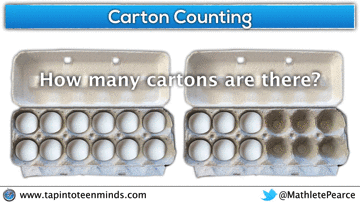Talking about Numbers
One of the ways to encourage students to think about Math is to encourage number talks regularly. These discussions encourage students to process their knowledge, expand their conceptual understanding and communicate their thinking so that others can understand. They can also be useful diagnostics to see what misconceptions or concepts are known before a topic is explored in class. These talks can be individual, or group activities but I find it best, especially for those introverted students, to start them off with at least a few minutes of individual think time. They can be done as a purely mental math task such as a dot card talk, but some questios may take some drawing or calculating to come to a solution. Typically a number talk is less than 15 minutes. I have found that they can take an entire 30 minute period if the discussion really gets going. You can choose to let the Math take you along the journey or you can set a timer and limit the time spent. There are many resources for this available to use.
I learned a great deal from reading Jo Boaler (Mathematical Mindsets and What's Math Got to Do with It) and using her website youcubed.org. I have also read other books such as Making Number Talks Matter by Cathy Humphreys.
Here are some of my favourite resources online:
Which One Doesn't Belong
This is a visual of four things. The students are asked which one doesn't belong to the group or find a reason for each one not to belong. Choose whichever version works with your students and the time you want to use. If you create your own, you can submit it as well. Many also show up via Twitter (https://twitter.com/WODBMath) so it is good one to follow. I project it onto the whiteboard and as the students give their answers, I write it beside the option.
 |
| Example of a WODB |
Estimation180 - Lots of great stuff here. Some of my newest ones to use though are the clothesline activities. If you haven't tried one, I would suggest doing so.
FractionTalks - new one for me, but I like the options. There are various categories such as square. The How-To section explains how to use them very well.
 |
| Example of a Square Fraction Talk |
Open Middle - These are lots of ways to search for problems. It is US based so you need to be aware of how the Standard Core compares to your curriculum if you are in Canada or another country (check here Canadian Correlations).
visualpatterns.org - this is just what it says, visual patterns, and there are over 200 of them to choose from right now. Recognizing patterns can be done with any grade though some of them are more exponential in nature. It can extend into Algebra by asking for a particular term number or for the equation.
 |
| Example of Visual Pattern |
Would You Rather - Give two options and students need to justify their choice. Really encouraged Math language and discussion.
 |
| Example of a Would You Rather |
Tap Into Teen Minds - Kyle Pearce has been doing some amazing things with this site and many of the animations make great number talks. The students get a visual and the Math which activates that cross brain activity that really helps them to understand the process and not just an algorithm.
There are also a lot of great tools that can be used to aid in either doing the number talks or to gather data before, during or after the discussion. The conversations and observations are useful data to record. How to effectively and efficiently gather that data, especially in rotary classes, is where I am currently trying to grow. Any ideas you would like to share on how you do it? (Please leave a comment below - would love to hear about it. )
These include (but are not limited to):
- Personal whiteboards
- Vertical Whiteboards
- Google Forms (Using their quiz feature or using Flubaroo add-on)
- Google Slides
- GoFormative
- Peardeck
I will discuss the tools I use in a subsequent post.
What are your favourite Number Talk resources?
What are your favourite Number Talk resources?

No comments:
Post a Comment